2019年电子书 百度百科名片.doc
百科资料
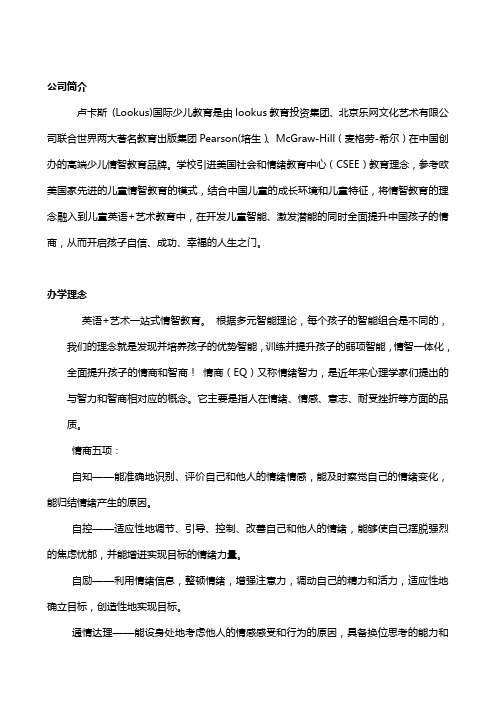
公司简介卢卡斯 (Lookus)国际少儿教育是由lookus教育投资集团、北京乐网文化艺术有限公司联合世界两大著名教育出版集团Pearson(培生)、McGraw-Hill(麦格劳-希尔)在中国创办的高端少儿情智教育品牌。
学校引进美国社会和情绪教育中心(CSEE)教育理念,参考欧美国家先进的儿童情智教育的模式,结合中国儿童的成长环境和儿童特征,将情智教育的理念融入到儿童英语+艺术教育中,在开发儿童智能、激发潜能的同时全面提升中国孩子的情商,从而开启孩子自信、成功、幸福的人生之门。
办学理念英语+艺术一站式情智教育。
根据多元智能理论,每个孩子的智能组合是不同的,我们的理念就是发现并培养孩子的优势智能,训练并提升孩子的弱项智能,情智一体化,全面提升孩子的情商和智商!情商(EQ)又称情绪智力,是近年来心理学家们提出的与智力和智商相对应的概念。
它主要是指人在情绪、情感、意志、耐受挫折等方面的品质。
情商五项:自知——能准确地识别、评价自己和他人的情绪情感,能及时察觉自己的情绪变化,能归结情绪产生的原因。
自控——适应性地调节、引导、控制、改善自己和他人的情绪,能够使自己摆脱强烈的焦虑忧郁,并能增进实现目标的情绪力量。
自励——利用情绪信息,整顿情绪,增强注意力,调动自己的精力和活力,适应性地确立目标,创造性地实现目标。
通情达理——能设身处地考虑他人的情感感受和行为的原因,具备换位思考的能力和习惯,理解和认可情感差别,能与自己观点不一样的人和平共处,理解被人的感受,察觉被人的真正需要,具有同情心。
和谐相处——能妥善处理人际问题,与他人和谐相处。
课程体系评测体系PTE少儿英语考试由培生集团推出,考试形式新颖,采用全球统一试卷、统一考试、统一评分、统一证书,所有考生资料全部寄送至英国,由英国国家学历职业认证机构直接向考生寄送合格证书。
PTE少儿英语考试将多种道具引进考场,使考场气氛轻松化。
在道具的帮助下,使听、说、读、写完美融合在虚拟情景中,从而真正衡量出考生的真实语言水平。
百度百科知识
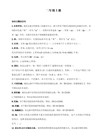
百科名片是对词条内容的概括总结,需要用户具有一定的词条编辑能力和经验,因此只有百科4级、通过率85%以上用户可以编辑
百科名片以概述和基本信息栏形式对词条进行简要介绍,帮助用户对词条内容简要理解
每个词条可以上传的图册数为15个,不受已有图片数限制。
百科词条正文的字数限制为20000个(多义项词条为每个义项20000)。
词条内容应公正客观,无过于主观语言
修改原因应写明编辑的主要内容,如编辑目录、增加概述、增加图片等。
:非正规产品不应当创建词条
百科词条应使用规范的语言文字
图册用多张图片展示同一个主题,信息量更大更全,浏览更集中
词条内容中蓝色可点击的词语就是词条链接,指向对应的百科词条。
目录位于正文之前。通过目录,可以大体了解词条的内容结构,也可以通过点击目录定位到相应位置。
百科词条名应为不带修饰词的陈述性词语。
百科链接应应添加在有与此条主题相关性的词上,不要增加无意义链接。
图片应注意选择尺寸较大、显示较清晰的,用来表达相应主题,但是不可以大段加粗操作。
词条中不能出现QQ号码、电子邮箱、外部链接等信息,否则会被判定为广告。
正文目录规则要求,词条应有至少两个一级目录,一个一级目录下应有至少两个二级目录。
百科核心用户、百科蝌蚪团、百科分类管理员,都是百科用户组成的科用户可以通过编辑、创建词条等贡献行为获得社区释,尽量做到准确、公正、客观,不应有疑问、感叹、评价等主观内容。
百科中有很多活动和任务者理解,可以加入概述图片、百科链接等内容。
在编辑词条时点击设置“一级目录”、“二级目录”,设置目录数达到2个以上就会生成百科目录。
每个词条可以上传的图片数为15张(不包括概述图片和图册内图片)。
张帆百度百科文案模版
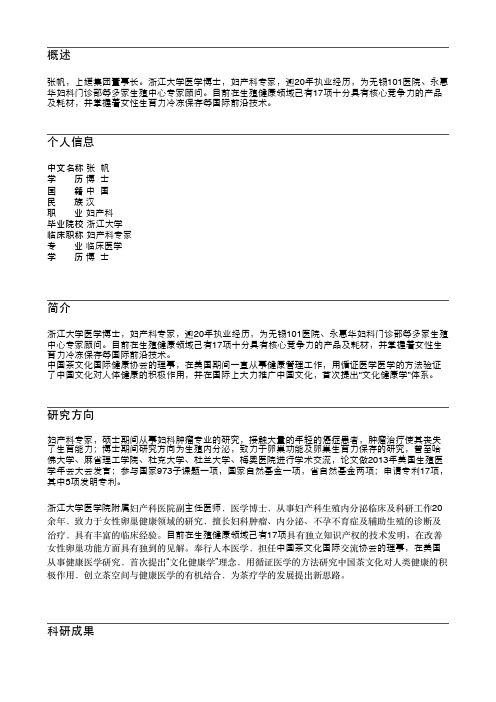
概述
张帆,上嫒集团董事⻓长。浙江大大学医学博士士,妇产科专家,逾20年执业经历,为无无锡101医院、永惠 华妇科⻔门诊部等多家生生殖中心心专家顾问。⺫目目前在生生殖健康领域已有17项十十分具有核心心竞争力力的产品 及耗材,并掌握着女女性生生育力力冷冻保存等国际前沿技术。
个人人信息
中文文名称 张 帆 学 历 博 士士 国 籍中 国 民 族汉 职 业 妇产科 毕业院校 浙江大大学 临床职称 妇产科专家 专 业 临床医学 学 历 博 士士
科研成果
多次受邀前往哈佛大大学、麻麻省理工工学院、杜克大大学、杜兰大大学、梅奥医院进行行学术交流,受邀在 2013年美国生生殖医学年会大大会作专题汇报;参与国家973子子课题一一项,国家自自然基金金一一项,省自自然 基金金两项;授权专利17项,其中5项发明专利。
ZL201310255431.8, 一一种感应性宫腔缓释系统, 发明专利 201310255153.6, 一一种一一次性助孕器, 发明专利 ZL201320841763.X, 单腔卵⺟母细胞采集器, 实用用新型 ZL201320848592.3, 活动铜⺴网网格片片冷冻组织保存载体, 实用用新型 ZL201320850090.4, 滑式冷冻组织切片片器, 实用用新型 ZL201320883462.3, B超引导下活检穿刺针, 实用用新型 ZL201320271194.X, 一一种助排尿音音乐盒, 实用用新型 ZL201320367007.8, 一一次性助孕器, 实用用新型 ZL201320366574.1, 感应性宫腔缓释系统, 实用用新型 ZL201320260209.2, 感应性阴道再造装置, 实用用新型 ZL201420468861.8, 一一种精子子染色色试剂盒, 实用用新型 2015SRS127312, 生生殖健康⺴网网平台, 软著 201310177009.5, 一一种感应性阴道再造装置, 发明专利 201510107072.0, 含有虾红素的提取物的组成物及其用用途, 发明专利 201410409370.0, 一一种提高高人人精子子活力力的体外培养体系试剂盒及其使用用方方法, 发明专利 201310703001.8, 一一种单腔卵泡细胞采集器, 发明专利 201510378273.4, 一一种利用用3D打印技术促进人人未成熟卵⺟母细胞体外成熟的方方法, 发明专利
中小学语文百科知识全书.doc
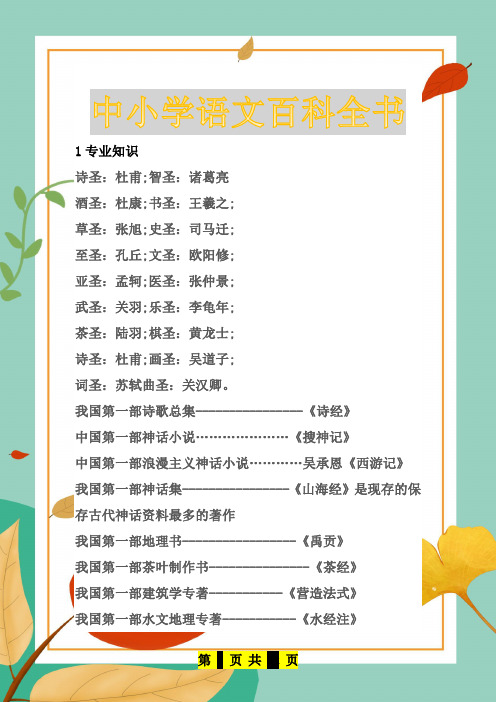
1专业知识诗圣:杜甫;智圣:诸葛亮酒圣:杜康;书圣:王羲之;草圣:张旭;史圣:司马迁;至圣:孔丘;文圣:欧阳修;亚圣:孟轲;医圣:张仲景;武圣:关羽;乐圣:李龟年;茶圣:陆羽;棋圣:黄龙士;诗圣:杜甫;画圣:吴道子;词圣:苏轼曲圣:关汉卿。
我国第一部诗歌总集----------------《诗经》中国第一部神话小说…………………《搜神记》中国第一部浪漫主义神话小说…………吴承恩《西游记》我国第一部神话集----------------《山海经》是现存的保存古代神话资料最多的著作我国第一部地理书-----------------《禹贡》我国第一部茶叶制作书---------------《茶经》我国第一部建筑学专著-----------《营造法式》我国第一部水文地理专著-----------《水经注》我国第一部文学批评专著--曹丕的《典论·论文》我国第一部文学理论和评论专著------刘勰的《文心雕龙》我国第一部诗歌理论和评论专著--------钟嵘的《诗品》中国第一部历史评论著作……唐·刘知几《史通》我国第一部绘画理论著作---------《古画品录》我国第一部系统的戏曲理论著作---《闲情偶寄》我国第一部著名的戏曲作品--------关汉卿的《窦娥冤》我国第一部戏曲史----------《宋元戏曲韵史》我国第一部军事著作----春秋o孙武《孙子兵法》我国第一部科普作品-------沈括的《梦溪笔谈》我国第一部日记体游记…………徐宏祖的《徐霞客游记》我国第一部图书分类总目录-----------《七略》我国第一部农业百科全书---------《齐民要术》中国第一部语录体著作………………《论语》中国第一部专记一个人言行的历史散文………《晏子春秋》中国第一部编年体史书………春秋·孔子《春秋》中国第一部记事详备的编年体史书…………春秋·左丘明《左传》中国第一部国别体史书……春秋·左丘明《国语》中国第一首长篇抒情诗………战国·屈原《离骚》中国第一部古代制度史………………《通典》中国第一部语法书…………………《马氏文通》中国第一部药曲……………………秦汉时期的《神农本草经》中国第一部总结历代名医医案的医学专著………………………明·江瓘《名医类案》中国第一部字典………东汉·许慎《说文解字》中国第一部词典…………汉代经师汇集《尔雅》中国第一部方言词典…………汉·杨雄《方言》中国第一部纪传体史书……汉·司马迁《史记》中国第一部断代体史书……………………………汉·班固《汉书》中国第一部最大的断代诗选………………清·彭定求等《全唐诗》中国第一部词集……………………………后蜀·赵崇祚《花间集》中国第一部植物学专著……………………晋·嵇含《南方草本状》中国第一部笔记小说……………………南朝·刘义庆《世说新语》中国第一部文选…………………………………南朝·梁·萧统《昭明文选》中国第一部光学物理专著………………………清·郑复光《镜镜冷痴》中国第一部汇编古代文化典籍的书……………《永乐大典》中国第一部长篇讽刺小说……………吴敬梓的《儒林外史》中国第一部个人创作的文言短篇小说集………蒲松龄《聊斋志异》中国第一部中篇小说……………鲁迅《阿Q正传》中国第一部白话短篇小说集………鲁迅《呐喊》中国现代第一篇白话小说……鲁迅《狂人日记》中国第一部杂文集………………鲁迅《坟》中国第一部散文诗集………………鲁迅《野草》中国现代文学史上的第一本小说集……………郁达夫《沉沦》中国现代第一部新诗集………郭沫若《女神》中国第一首信天游形式民歌体叙事长诗……李季《王贵与李香香》中国第一篇报告文学作品………夏衍《包身工》中国第一个新文学社团……………………文学研究会,1921年成立中国第一位史学家、文学家……………司马迁中国第一位伟大的爱国主义诗人…………屈原中国第一位女诗人……………………蔡文姬中国第一位田园诗人…………………陶渊明中国第一位著名女词人………………李清照中国新文学史上第一位伟大诗人……郭沫若中国第一位儿童作家…………………冰心中国第一个开拓童话园地的作家……叶圣陶中国第一位获得"人民艺术家"称号的作家……………………老舍2古诗诗中春1.春眠不觉晓,处处闻啼鸟。
认识百度(三)-百度百科操作技巧PPT课件
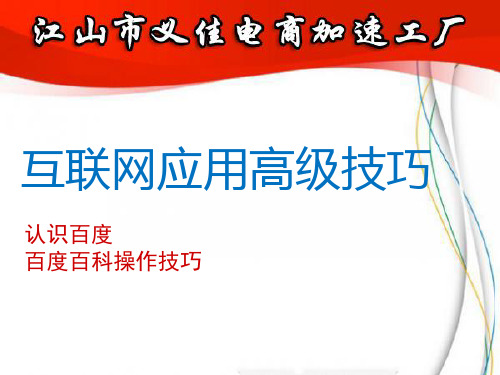
3.参考资料和扩展阅读一定要跟词条相关,一次不要添加太 多。可以注册多个账号,多次添加完善。
4.根据自己的网站内容,写出一些相关的词,热门词也好, 长尾关键词也行,只要在百科里是可以创建的词条,我们 就可以创建。我们想做的词可以是和我们同行业相关的词 ,范围很大!比方说,我们公司是做网上药房的,我们可 以做网上关联,尽量提交准确的信息描述 ,这样能有效的保护你的账号。
• 一个好的账号(级数高,通过率高)的优势有: • (1)以后编辑的词条会更容易通才能修改的。
• 2.在文中带广告、有链接的文字或者QQ号码等,基本上 就调用户的参与和奉献精神,充分调动互联网用户的力量, 汇聚上亿用同的层次上满足用 户对信息的需求。
认识词条
词条作为百科的重要组成部分,承担着传递着知识的光荣使 命,作为百科知识先锋的一份子,如何把词条编辑地条理清晰是我 们必备的素质。
以俱乐部官方词条为例 /view/9620337.htm
开放分类
设置开放分类的主要目的在于帮助用户浏览到相关的词条信 息。在给词条设置开放分类的时候要注意一下几个问题:
1.必须与词条以及词条内容相关,不可以完全无关。例如,“长 城”的开放分类可以允许有“建筑”,但是“社会科学”这个开放分类 显然是不正确的。
• 5.开放分类
开放分类是指比传统的目录式分类更灵活、更具自主性的分类方式 。它可根据词条的不同属性而添加多个分类。比如词条“珠穆朗玛峰”可设置“ 西藏”、“喜马拉雅山脉”、“地理”等开放分类。
• 6.相关词条
相关词条是与当前词条具有较为紧密的关联的词条。比如“贾宝玉”的相关词条可以 是“林黛玉”、“薛宝钗”。
• 7.同义词
同义词是名称不同但表达的词条意思相同的词条,例如“湖南省”和“湖南”是同义 词。为了避免用户提词,并以其中较为规范或较为常用的词条作为标准词。例如 将“北京大学”作为“北大”的标准词。
百度百科
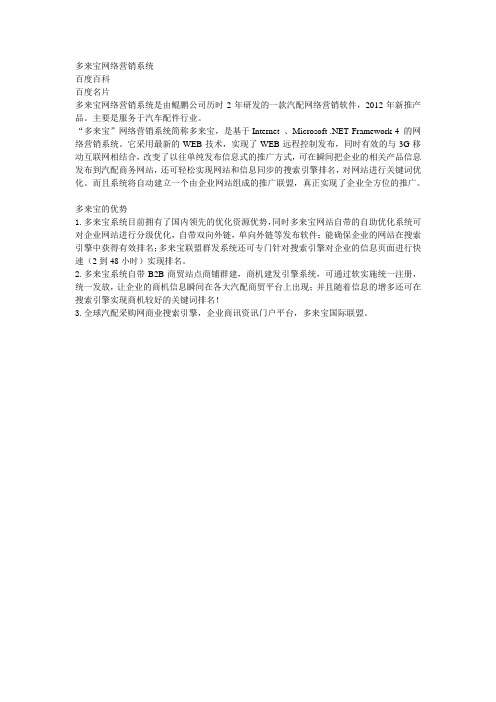
多来宝网络营销系统
百度百科
百度名片
多来宝网络营销系统是由鲲鹏公司历时2年研发的一款汽配网络营销软件,2012年新推产品。
主要是服务于汽车配件行业。
“多来宝”网络营销系统简称多来宝,是基于Internet 、Microsoft .NET Framework 4 的网络营销系统。
它采用最新的WEB技术,实现了WEB远程控制发布,同时有效的与3G移动互联网相结合,改变了以往单纯发布信息式的推广方式,可在瞬间把企业的相关产品信息发布到汽配商务网站,还可轻松实现网站和信息同步的搜索引擎排名,对网站进行关键词优化。
而且系统将自动建立一个由企业网站组成的推广联盟,真正实现了企业全方位的推广。
多来宝的优势
1.多来宝系统目前拥有了国内领先的优化资源优势,同时多来宝网站自带的自助优化系统可对企业网站进行分级优化,自带双向外链,单向外链等发布软件;能确保企业的网站在搜索引擎中获得有效排名;多来宝联盟群发系统还可专门针对搜索引擎对企业的信息页面进行快速(2到48小时)实现排名。
2.多来宝系统自带B2B商贸站点商铺群建,商机建发引擎系统,可通过软实施统一注册,统一发放,让企业的商机信息瞬间在各大汽配商贸平台上出现;并且随着信息的增多还可在搜索引擎实现商机较好的关键词排名!
3.全球汽配采购网商业搜索引擎,企业商讯资讯门户平台,多来宝国际联盟。
2019年百度词典范文.doc
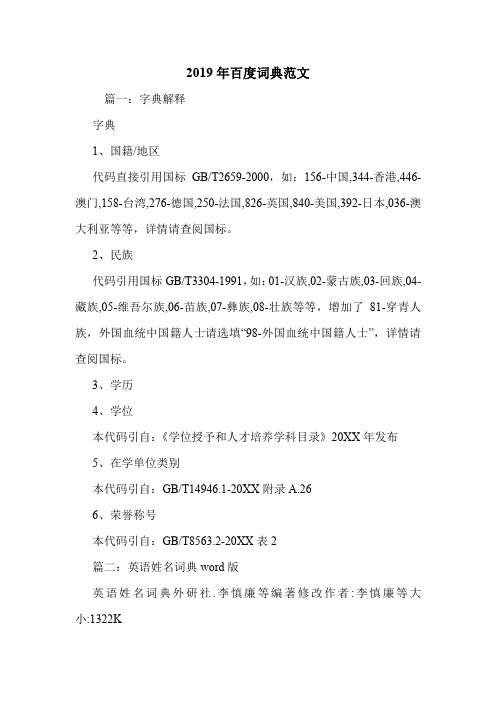
2019年百度词典范文篇一:字典解释字典1、国籍/地区代码直接引用国标GB/T2659-2000,如:156-中国,344-香港,446-澳门,158-台湾,276-德国,250-法国,826-英国,840-美国,392-日本,036-澳大利亚等等,详情请查阅国标。
2、民族代码引用国标GB/T3304-1991,如:01-汉族,02-蒙古族,03-回族,04-藏族,05-维吾尔族,06-苗族,07-彝族,08-壮族等等,增加了81-穿青人族,外国血统中国籍人士请选填“98-外国血统中国籍人士”,详情请查阅国标。
3、学历4、学位本代码引自:《学位授予和人才培养学科目录》20XX年发布5、在学单位类别本代码引自:GB/T14946.1-20XX附录A.266、荣誉称号本代码引自:GB/T8563.2-20XX表2篇二:英语姓名词典word版英语姓名词典外研社.李慎廉等编著修改作者:李慎廉等大小:1322KAAaron艾伦:源自希伯来语,含义“力量之山”(mouwntamofstrength)男子名。
Abadam阿巴达姆:取自父名.源自ab+Adam,含义“亚当之子”(sonofAdam),威尔士人姓氏。
Abbe艾贝:Abbey异体,英格兰人姓氏。
Abbet艾贝特:Abbott的异体,英格兰人姓氏Abbey阿比:地貌名称,修道院;或职业名称,在修道院任职者;源自中世纪英语,英格兰人姓氏。
Abbot阿博特,Abbott的异体,英格兰人姓氏Abbott阿博特:职业名称,在男修道院院长家任职者;或绰号,像男修道院院长的假装虔诚的人;源自阿拉姆语,含义“教父,圣父”(father),英格兰人姓氏Abbs阿布斯:取自父名,源自Abel,含义“艾贝尔之子”(sonofAbel),英格兰人姓氏Abby1艾贝:Abbey异体,英格兰人姓氏,2.Abigail的昵称,女子名。
Abdey阿布迪:Abbey的的异体,英格兰人姓氏Abdle阿布迪Abbey的异体,英格兰人姓氏Abe艾贝:Abraham的昵称,男子名Abel艾贝尔:源自希伯来语教名,含义“气息,活力;虚荣”(b reth,vigtxrnvanity),英格兰人姓氏,男子名。
怎么编辑、创建百度百科名片,百度百科创建编辑名片方法
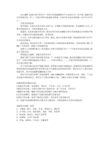
怎么编辑、创建百度百科名片?百度百科创建编辑名片方法是什么?在百度上搜索百度百科的排名是一至三,百度百科作为权威参考资料,百度百科以成为网络推广必不可少环节之一。
百度百科的优势排名靠前:百度百科是百度自己的产品,百度赋予其极高的权重,无论搜索什么词,百度百科的排名无一不例外都是前几名。
权威性:无论是创建百度百科、修改百度百科还是删除百度百科均要通过百科团队严格审核,以确保百科词条的权威性、参考价值。
长久性:百科词条创建后永久有效、稳定,国内专业做百科推广的优渡网承诺可以不产生任何后续费用。
转化率高:网民信任百科,百科成为网民上网查资料必看的网站,其转化率较PPC及PM广告高得多。
(得益于其权威性高)流量大:百度指数50以上的关键词,其每日浏览量不亚于一个中型企业站的总流量。
(得益于其排名好)那到底怎么编辑、创建百度百科名片既然了解了百度百科的优势及用途,下一步就是学习创建、修改或者删除百度百科的方法了。
百度百科要创建成功主要有:一、百度百科账号,二、百度百科所积累的经验,三,对百度百科的了解。
由于百科词条内容有严格编写规范,低等级百科账号限制较多,需要提供各种权威参考资料(如果没有权威资料百科审核员是不可能通过的)等原因导致一般企业及个人难以成功创建百科,更不用说编辑或删除他人百科。
国内专业百度百科推广机构优渡网(QQ: 120962274)在接到来自企业、商家、个人众多创建百科的请求后,研究出了百度百科解决方案,可解决大部分百科推广的需求。
优渡网提供的服务包括:1.创建百科词条,如品牌名、网站名、产品词、人名、公司名等2.修改百科词条,在原有词条中加入您的内容,如广告内容、百科名片3.删除百科词条,删除不利词条内容或整个词条(不推荐使用)4.百科内容撰写,根据客户及编写规范撰写词条内容5.维护百科词条,按客户要求包月维护,部分竞争大的词条另议注:创建百科前最好整理出词条名及大概内容,以便优渡网人员及时为您处理。
Introduction1

Chapter 1: IntroductionRegional anaesthesia has increased in popularity in recent years (Clergue et al., 1999). This was prompted by two significant events. Firstly, the realisation that children do feel pain and require pain relief like adults; and secondly, that avoiding general anaesthesia in premature babies may have major advantages.With the increased survival of premature infants in recent years, the number of premature neonates presenting for surgery has increased. These premature neonates present with either chronic or acute defects that urgently need to be corrected. The risk of general anaesthesia is significant in these patients as they are at a greater risk of developing respiratory failure and postoperative apnoea compared to term infants of the same age (Welborn et al., 1986). Recent concerns regarding the deleterious effects of general anaesthesia on the developing brain further justifies the use of regional anaesthesia in this vulnerable age group (Sun et al. 2008).The use of regional anaesthesia therefore may have considerable advantages not only in premature neonates but also in infants, children and adults. The stages of development can be classified as follows: Stage 1: Neonate or newborn (0-30 days), Stage 2: Infant or baby (1 month-1 year), Stage 3: Toddler (1-4 years), Stage 4: Childhood (prepubescence) (4-12 years), Stage 5: Adolescence and puberty (12-20 years), and Stage 6: Adulthood (21 years - death), which can be subdivided into early adulthood (21-39 years), middle adulthood (40-59 years) and advanced adults/senior citizen (older than 60 years) (Jones, 1946).1.1) A brief history of paediatric regional anaesthesiaThe 19th century was a time when fundamental changes were made in the concepts regarding medicine. This is especially true for the speciality of regional anaesthesia. It is also the period regarded as the birth of modern regional anaesthesia (Bonica, 1984; Dalens, 1995). The thought that the heart is the centre for pain reception was discounted and Bell in 1811 andMagendie in 1822 showed that both motor and sensory impulses were relayed by the nerve tracts. By 1840, Muller established that the brain is the centre for perception and received all sensory information, including pain stimuli (Dalens, 1995).August Bier is commonly regarded as the “father of regional anaesthesia” and discovered the “cocainization of the spinal cord”, using a spinal anaesthetic technique (Fortuna & de Oliveira Fortuna, 2000). Since then, the regional anaesthetic techniques of the time included spinal, caudal epidural and supraclavicular brachial plexus blocks. These procedures gained enthusiastic acceptance by the anaesthesiologists of the time (Bainbridge, 1901; Farr, 1920; Campbell, 1933). However, these procedures gradually fell into disuse and almost came to a complete halt after the Second World War. This was mainly due to the development of new anaesthetic agents and improved techniques for general anaesthesia, which were safer and more reliable to use.The nineteen seventies saw a re-emergence of paediatric regional anaesthesia. Studies conducted by Lourey and McDonald (1973), Kay (1974) and Melman et al. (1975) caused a resurgence in the popularity of paediatric regional anaesthesia. The concept that regional and general anaesthesia can be used in a complimentary fashion, rather than being in contention with each other, also gained increasing acceptance (Dalens, 1995).This increase in regional anaesthesia could be attributed to the constant refinement, and/or development of new techniques. Research into newer, safer and better local anaesthetic solutions, as well as the use of continuous infusions through pumps, has offered new ways of providing pre- and post-operative analgesia to patients scheduled for paediatric surgery (Cook et al., 1995). With the above-mentioned advances in the field of anaesthesiology, the need for a strict protocol for administration, with reliable equipment, well-trained and alert personnel, become even more important (Fortuna & de Oliveira Fortuna, 2000).1.2) The importance of clinical anatomy in regional anaesthesiaDespite all the opportunities in medical research today, as well as the advances made in medical technology, the effective performance of clinical procedures still rests on a solid anatomical basis. This is even more important for medical practitioners in developing countries where technology is often lacking and they are dependent on their anatomical knowledge for the successful performance of clinical procedures (AACA, EAC, 1999).The practice of regional nerve blocks relies heavily on a sound knowledge of clinical anatomy (Winnie et al., 1975). This is especially true for anaesthesiologists who perform these blocks on paediatric patients (Bosenberg et al., 2002). Clinical procedures, such as regional nerve blocks, which either fail to achieve their objective or that result in complications, can often be linked to a lack of understanding, or even misunderstanding, of the anatomy relevant to the specific procedure (Ger, 1996; AACA, EAC, 1999).Winnie and co-workers (Winnie et al., 1973) states that no technique could truly be called simple, safe and consistent until the anatomy has been closely examined. This is quite apparent when looking at the literature where many anatomically based studies regarding regional techniques have resulted in the improvement of the technique, as well as the development of safer and more efficient methods. Anaesthesiologists performing these procedures should have a clear understanding of (a) the anatomy, (b) the influence of age and size, and (c) the potential complications and hazards of each procedure to ensure good results (Brown, 1985). Ellis and Feldman (1993) stated that anaesthesiologists required a particularly specialised knowledge of anatomy, which in some cases should even rival that of a surgeon. There is however a distinct lack of studies focusing on the anatomy of a paediatric population and relating it to a clinical setting (van Schoor et al., 2005). The anatomy described for paediatric patients are in most instances, obtained from adults and could be flawed (see Table 3.1 for an example).Performing regional anaesthetic procedures on paediatric patients have some additional complications and problems associated with it. Many anaesthesiologists may not be comfortable with working on a dose/weight basis. Most importantly, many anaesthesiologists not used to working with paediatric patients may lack the knowledge of the relative depths or position of certain key anatomical structures, as it is known that the anatomy of children of different ages may differ to a greater or lesser degree from that of adults (Bosenberg et al., 2002, Brown, 1985, Brown & Schulte-Steinberg, 1988, Katz, 1993). A thorough knowledge of the anatomy in children is therefore essential for successful nerve blocks and it cannot be substituted by probing the patient with a needle attached to a nerve stimulator, while the effective use of ultrasound requires a sound knowledge of the anatomy of the specific region. The anatomy described in adults is not always, and in most instances not applicable, to children of different ages as anatomical landmarks in children vary with growth. Bony landmarks (e.g. the greater trochanter of the femur) are poorly developed in infants prior to weight bearing. Muscular and tendinous landmarks commonly used in adults, tend to lack definition in young children partly because of poorer muscle development (Bosenberg et al., 2002), but also because they require patient cooperation to locate them. Most children are under sedation or general anaesthesia when the nerve block is being performed (Bosenberg et al., 2002, Armitage, 1985). Finally, classical anatomical landmarks may be absent or difficult to define in children with congenital deformities (Bosenberg et al., 2002).1.3) Indications and limitations of paediatric regional anaesthesiaRegional anaesthesia has advantages over general anaesthesia since it covers not only the intra-operative but also the postoperative period. Regional anaesthesia can be used to treat both acute and chronic pain and, in addition, it also provides both sympathetic and motor blockades (Saint-Maurice, 1995). Like all clinical procedures, the indications of regional anaesthetic techniques is based on well-established criteria, such as patient safety, quality of analgesia, duration of surgery, and whether it is a minor ormajor surgical procedure (Melman et al., 1975; Armitage, 1985; Saint-Maurice, 1995, Markakis, 2000, Wilder, 2000).Indications should not be decided by the subjective preferences of the anaesthesiologist or on the basis of mastery of the specific technique (although this is vital when the procedure is actually performed), but solely on whether the technique is required by careful examination of the indications (Saint-Maurice 1995). In order to select the best anaesthetic technique available, the benefits and risks of the regional nerve block should first be weighed against the advantages and disadvantages of all other available techniques of analgesia (Dalens & Mansoor, 1994).1.3.1 General indications of regional anaesthesiaPatients often have certain medical conditions, where the use of regional nerve blocks would be an advantage, these include:1.3.1.1 Disorders of the respiratory tractThe presence of respiratory diseases is in most cases (except the interscalene block, which has a high incidence of blocking the phrenic nerve) an indication for the use of regional anaesthesia. A regional nerve block can safely be performed on paediatric patients with respiratory distress, provided that the needle insertion, as well as the surgical site, is easily accessible. In certain cases, regional anaesthesia can be performed under mild general anaesthesia, after the patient has been intubated. In these situations, peripheral nerve blocks may be more preferable than central blocks. The advantages of combining both regional and general anaesthesia include reducing the requirements for intravenous and inhalational agents, thereby decreasing the risk of complications and also decreasing the recovery time. The patient should be extubated only when fully conscious and with the effect of anaesthetic inhalant worn off. This will allow the anaesthesiologist to effectively avoid aspiration (Saint-Maurice, 1995).1.3.1.2 Disorders of the central nervous systemThis is often considered to be a contraindication for performing regional nerve blocks. It is however more likely that an anaesthesiologist would refrain from performing regional nerve blocks on these patients more from the fact that there is a concern that the regional nerve block might worsen the disease state. The only true contraindications for performing regional nerve blocks on these patients are mechanical (neuropathy) and infectious conditions (infections in the vicinity of the block). Nevertheless, all children with disorders of the central nervous system should undergo careful evaluation before performing any regional nerve block on them. A neurologist should preferably do the evaluation and, as always, the risk versus benefit ratio should be carefully examined. (Saint-Maurice 1995)myastheniaand1.3.1.3 MyopathyRegional anaesthesia is especially indicated for patients with muscular dystrophy because it avoids the complications associated with general anaesthesia, particularly malignant hyperthermia. Unfortunately, due to the various anatomical deformities often found in these patients, certain regional nerve blocks might be more difficult to perform (Saint-Maurice 1995).1.3.2 General contraindications or limitations of regional anaesthesiaRegional anaesthesia has a very important place in children. Like any technique, it has its distinct advantages and specific indications. However, it also has limitations, disadvantages and contraindications that should be taken into account when performing regional blocks. Although contraindications are block dependant and should be known before attempting any regional nerveblock, general contraindications for regional anaesthesia include:1.3.2.1 Patient refusalPatient refusal is an absolute contraindication to regional anaesthesia. Appropriate information should be given to the patient regarding the technique, its advantages, disadvantages and potential complications. Informed consent must be obtained (Eledjam et al., 200).1.3.2.2 Local infections at the needle insertion siteSkin infections at the needle insertion site are an absolute contraindication to regional anaesthesia(Ecoffey & McIlvaine, 1991). This is also true for inflammation of the lymph nodes near the site of needle insertion.1.3.2.3 Septicaemia(presence of pathogens in the blood)1.3.2.4 Coagulation disordersCoagulation disorders, as well as patients who are undergoing antithrombotic or anticoagulant treatment are contraindications to a regional block because of the potential risk of haematoma formation (Dalens, 1995; Ecoffey & McIlvaine, 1991). Most of the complications have been described with epidural anaesthesia due to multiple traumatic vascular punctures and needle placement difficulties (Dalens, 1995).involving the peripheral nerves 1.3.2.5 Neurologicaldiseases(neuropathy)Although neuropathy (due to neurological or metabolic diseases) is not an absolute contraindication to perform a regional block, a clear benefit over general anaesthesia should be made (Ecoffey & McIlvaine, 1991).1.3.2.6 Allergy to the local anaesthetic solutionLess then 1% of all adverse reactions to local anaesthetics are due to patient allergy to the solution (Ramamurthi & Krane, 2007). Ester-linked local anaesthetics which are metabolized to para-amino benzoic acid (PABA) are far more likely to be associated with allergic reactions compared to amide local anaesthetics. Allergic reactions with amide local anaesthetics have yet to be reported in medical literature, although preservatives like methylparaben, present in many commercial preparations of amide local anaesthetics, are responsible for occasional allergic reactions (Naguib et al., 1998). Ester local anaesthetic allergies are true anaphylactic IgE-mediated allergies and not anaphylactoid reactions more commonly associated with other drugs used in the practice of anaesthesia (Ramamurthi & Krane, 2007).1.3.2.7 Lack of trainingAdequate skills regarding a specific technique are essential for a successful procedure to avoid complications and malpractice claims. Skills and expertise are key points to success in regional anaesthesia (Eledjam et al., 2000).1.4) Equipment used for paediatric regional anaesthesiaThe importance of selecting the appropriate devices and have them readily available when performing a regional block in children has long been underestimated and virtually all types of needles have been used for almost all types of block procedures (Dalens, 1999). Specifically designed needles and catheters are currently available for paediatric regional anaesthesia and it is now well established that a significant proportion of complications are directly related to the use of the wrong device (Giaufre et al., 1996). The importance of the correct equipment for a successful block was further confirmed in a survey of South African paediatric anaesthesia (van Schoor, 2004).Dalens (1999) stated that in addition to skin preparation solutions and sterile drapes to protect the site of puncture from bacterial contamination, the materials required to perform local or regional anaesthesia are rather simple but, nevertheless, specific. Sterile needles specifically designed to perform the relevant technique have to be used in children. He summarised the relevant equipment in a table (see Appendix A).An intravenous cannula should always be inserted in either the upper or lower limb in case of local anaesthetic toxicity caused by an accidental intravenous injection, or profound sympathetic blockade from a high epidural block. Light general anaesthesia is normally given to the paediatric patient. The procedure must be carried out with a strict aseptic technique. The skin should be thoroughly prepared and sterile gloves must be worn as infection in the caudal space is extremely serious (Jankovic & Wells, 2001).1.5) Imaging techniques used to aid in regional anaesthesia1.5.1 Nerve stimulators and regional anaesthesiaThe idea of stimulating a motor nerve in order to determine the ideal injection site for regional anaesthesia was first suggested by Von Perthes in 1912. Although, only within the past twenty years, have peripheral nerve stimulators (see Figure 1.1) become popular as clinical and teaching tools in regional anaesthesia practice (Visan et al., 2002). Nerve stimulators enable confirmation of the correct needle placement without inducing paraesthesia (Vloka et al., 1999) and, in turn, allow anaesthesiologists to perform the block in sedated or anaesthetised patients (Brown, 1993).Figure 1.1: Some commercially available peripheral nerve stimulators(Vloka et al., 1999).Since Pither et al. (1985) made recommendations on the use of nerve stimulators in regional anaesthesia; there has been an explosion of new and varied nerve stimulators available on the market. Although the advances in the technology surrounding nerve stimulators have made their use to localise the desired nerve(s) much easier, the wide variety of functions and features can be confusing for first-time users. This could in turn leave anaesthesiologists with an insufficient understanding of the basic principles behind nerve stimulation.principles of nerve stimulation1.5.1.1 BasicNerve stimulation techniques rely on the elicitation of appropriate motor responses to electrical current to confirm the proximity of the needle or catheter to the target nerve structure. Typically, nerve stimulation involves application of electrical current once the needle/catheter has penetrated the subcutaneous tissue, although surface mapping by transcutaneous electrical stimulation of peripheral nerves in children has been described (Bosenberg et al., 2002).The relationship between the strength and duration of the current and the polarity of the stimulus is of particular importance to nerve stimulation (Pither et al., 1985). To propagate a nerve impulse, a certain threshold level ofstimulus must be applied to the nerve. Below this threshold, no impulse ispropagated. Any increase of the stimulus above this threshold results in a corresponding increase in the intensity of the impulse (Tsui, 2007).It is also possible to estimate needle-to-nerve distance by using a stimulus of known intensity and pulse duration. A clear motor response achieved at 0.2 to 0.5 mA indicates an appropriate needle-to-nerve relationship. The tip of the needle is therefore close enough to the desired nerve to cause an effective block if the anaesthetic solution is administered. Nerve stimulation at <0.1 mA may indicate intraneural placement of the needle. This should be avoided as it may lead to nerve injury if the local anaesthetic is injected (Visan et al., 2002).Another important aspect to remember is that the cathode can be up to four times more effective at nerve depolarization than the anode, and thus it is the preferred stimulating electrode. Some problems may arise when nerve stimulators are not made to connect properly for other manufacturers’ stimulating needles and an adapter would therefore be required. It is best to use similarly manufactured stimulators and needles if possible (Tsui, 2007).A surface electrode is required to complete the electrical circuit and the optimal position to place the electrode on the patient’s body during peripheral nerve blocks is controversial (Tsui, 2007). According to Hadzic and co-workers (2004), this is less critical than was previously thought due to the introduction of constant-current nerve stimulators.features of nerve stimulators1.5.1.2 EssentialAccording to Visan et al. (2002), the essential features of the nerve stimulator include:•Constant current output: This assures automatic compensation for changes in tissue or connection impedance during nerve stimulation, inturn, assuring accurate delivery of the specified.•Current display: The ability to read the current being delivered is of utmost importance because the current intensity at which the nerve is stimulated gives the operator an approximation of the needle-to-nerve distance.•Current intensity control: Current can be controlled using either digital means or an analogue dial. Alternatively, current intensity can be controlled using a remote controller, such as a foot pedal, which allowsa single operator to perform the procedure and control the currentoutput (Hadzig & Vloka, 1996)•Short pulse width: Many peripheral nerve stimulators lack the ability for the user to control pulse width.•Stimulating frequency: Nerve stimulators with a 1 Hertz (Hz) stimulation frequency (1 pulse per second) are the norm. A model with a 2 Hz stimulation frequency may prove to be more clinically advantageous because it allows faster manipulation of the needle.•Malfunction indicator: This is a necessary feature because the operator should know when the stimulus is not being delivered because of malfunctions such as poor electrical connection and/or battery failure.A study conducted by Bosenberg (1995) revealed that a relatively cheap, unsheathed needle could be successfully used to locate peripheral nerves with the aid of a nerve stimulator in anaesthetised children. Although a slightly larger current is required to produce a motor response when compared to sheathed needles, a success rate of greater than 98% underlines its value as a cost-effective teaching tool, and the ease with which a technique can be mastered when using a nerve stimulator.Surface nerve mapping or transdermal nerve stimulation is a modification of the standard nerve stimulator technique and can be used to trace the path of a nerve prior to skin penetration. Surface nerve mapping could prove to be most useful in paediatric patients since anatomical landmarks are less precisely defined (Bosenberg et al., 2002), and paediatric patients are at the greatest risk for complications of regional anaesthesia.(Giaufre et al.,1996) Nerve mapping offers a further dimension for localisation of superficial peripheral nerves prior to skin penetration in both infants and children (Bosenberg et al.,2002).For locating superficial nerves, in patients of normal weight or paediatric patients, a special device can be used together with the nerve stimulator to trigger a transdermal response from the target muscle. The pulse duration of the device is set to 1 millisecond (ms) and the current range to 5 mA. In this way, it is possible to get a better fix on the puncture site or even correct the puncture direction. This also serves as an invaluable training tool for anaesthesiologists. Not only can the correct stimulus response be demonstrated but needle localisation and direction can be practiced before the needle is inserted (, 2009)Bosenberg and co-workers (2002) stated that peripheral nerve stimulation should not be a substitute for sound anatomical knowledge and careful technique. In a study, they did however show that using a nerve stimulator does provide a greater degree of reliability and accuracy in finding the correct needle insertion site, compared to using only anatomical landmarks or paraesthesias to perform nerve blocks. It is also a safer technique for attaining close proximity to the actual nerve.A combination of using a nerve stimulator/surface nerve mapping device and anatomical landmarks seem to be the best method for accurate, safe and successful blockade (Bosenberg, 1995).1.5.2 Ultrasound guidance and regional anaesthesia1.5.2.1 Advantages of ultrasound guidance during regional anaesthesiaThe use of ultrasound guided techniques for performing regional anaesthesia has greatly increased within the past decade. Recent studies show that ultrasound guided nerve blocks may have many advantages over traditional techniques. These studies reported less vascular puncture, highersuccess rates, and a reduced dose of local anaesthetic required in order to obtain a successful block (Marhofer et al., 2004; Sandhu et al., 2004; Bigeleisen, 2007).1.5.2.2 Basic principles of ultrasoundUltrasound machines can typically deliver sound waves of 2–15 MHz. Characteristically, the higher the frequency, the less the penetration depth but the better the resolution and vice versa. In the paediatric population, a high frequency linear probe is usually sufficient as the anatomy is much smaller and most structures being blocked are reasonably superficial. Sound waves propagate through the body and the amplitude of the reflected signals is based on different acoustic impedance of human tissue and fluids. Signals of least intensity appear dark (hypoechoic) or black as with body fluids, while signals of greatest intensity appear white (hyperechoic) as with bones and with intermediate intensities appearing as shades of gray. A common artefact is anisotropy, which is caused by an incidence angle of less than 90o between the probe and the structure being imaged. This results in poor or no reflection of the ultrasound beam from the tissue and, consequently, an inability to visualise it. The ultrasound beam must be oriented perpendicularly on the nerve axis to be able to visualise it (Marhofer et al. 2005; Brain et al., 2007).regional anaesthesia:1.5.2.3 UltrasoundguidedThe success of ultrasound guided nerve blocks relies on several aspects (Perlas & Chan, 2008):•Quality of image: This depends on the quality of the ultrasound machine and transducers, proper transducer selection (e.g., frequency) for each nerve location, sonographic anatomy knowledge pertinent to the block, and good hand-eye coordination to track needle movementduring advancement.•Patient position and technique: Optimal patient positioning and sterile technique is essential. This is particularly important for the continuouscatheter technique when it is necessary to use sterile conducting geland a sterile plastic sheath to fully cover the entire transducer.•Nerve stimulation: Nerve localisation by ultrasound can be combined with nerve stimulation. Both tools are valuable and complementary andnot mutually exclusive. Ultrasonography provides anatomical information, while a motor response to nerve stimulation provides functional information about the nerve in question.•Spread of anaesthetic solution: Ultrasound allows the anaesthesiologist to observe the spread of the local anaesthetic solution as well as real-time visual guidance to navigate the needle toward the target nerve.Two approaches are generally available to block peripheral nerves. The first approach aims to align and move the block needle inline with the long axis of the ultrasound transducer, so that the needle stays within the path of the ultrasound beam (see Figure 1.2a). In this manner, the needle shaft and tip can be clearly visualized. This approach is preferred when it is important to track the needle tip at all times (e.g., during a supraclavicular block to minimize inadvertent pleural puncture). The second approach places the needle perpendicular to the probe (see Figure 1.2b). In this case, the ultrasound image captures a transverse view of the needle, which is visible as a hyperechoic "dot" on the screen. Accurate moment-to-moment tracking of the needle tip location can be difficult, and needle tip position is often inferred indirectly by tissue movement. This approach is particularly useful for continuous catheter placement along the long axis of the nerve.。
电子名片介绍

基本定义电子名片是一种图文、声像并茂的多媒体“光盘名片”,运用现代化高科技手段融入视频和声音等多媒体元素,把企事业单位的文字、图片、视频、声音等多媒体宣传资料整合成一种自动播放的多媒体文件刻录到名片大小的光盘上,是名片和企业宣传画册的结合体,应用范围比传统纸质名片和印刷画册更广泛。
电子名片容量大,如果控制合理的话可以存放1000页A4幅面的内容。
适于政府招商引资,介绍当地的各种资源;企业推销自己的产品、服务;成功人士塑造自己的对外形象等等。
随电脑设备的普及,电子名片将会越来越显示出它的适用性,人们将越来越离不开电子名片。
电子名片不但新颖,时尚,而且非常实用,适用于任何商家,企事业。
电子名片是名片中的极品,是名片中的“绅士”。
是现代政要和企业老板身份的象征。
是今后企事业单位必备的宣传品,市场前景非常广阔。
背景需求经济自改革开放以来,中国经济飞速发展,老百姓过上了历史上前所未有的好日子,人们生活越来越优越,生活需求越来越多,各行业产业链也就逐渐完善起来,近几年由于“经济过剩”很多行业也渐入萧条,新的产业洗牌正在开始,优胜劣汰已成必然趋势。
企业在提高自身管理水平和产品体系达到一定水平后,都在不懈的宣传自己,想尽各种方法加深自己在公众心目中的印象,树立好自身品牌形象,低成本高效果的宣传媒介是必然选择……企业截至2006年底,中国共有中小企业2930万个。
此外还有媒体报道称,“中国工商注册登记的中小企业占到了全国企业总数的99%,达到2000多万家。
”在大量的文献中还可以看到这样的引用,“根据国家经贸委中小企业司最新数据统计,国内中小企业数量是1100万家”,此外,原国家经贸委副主任张志刚曾说,近两年中国中小企业已经超过800万家。
国家工商总局也曾经公布过,中国企业数量为800万家。
而据国家统计局发布的《第二次全国基本单位普查主要数据公报》,2006年末,中国共有法人单位510.7万个,其中企业法人302.6万个。
2019年电子书 百度百科名片.doc
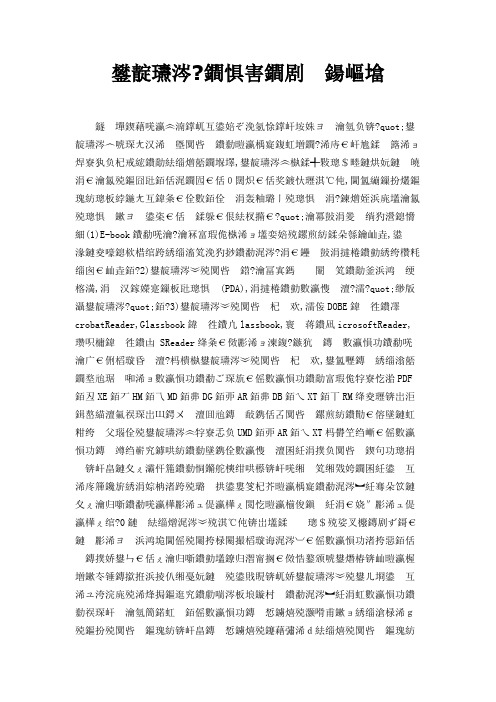
电子书百度百科名片目前国内学术界以及社会各界初步认定为:"电子书代表人们所阅读的数字化出版物,从而区别于以纸张为载体的传统出版物,电子书是利用计算机技术将一定的文字、图片、声音、影像等信息,通过数码方式记录在以光、电、磁为介质的设备中,借助于特定的设备来读取、复制、传输。
"它由三要素构成:(1)E-book的内容,它主要是以特殊的格式制作而成,可在有线或无线网络上传播的图书,一般由专门的网站组织而成。
(2)电子书的阅读器,它包括桌面上的个人计算机,个人手持数字设备(PDA),专门的电子设备,如"翰林电子书"。
(3)电子书的阅读软件,如ADOBE公司的AcrobatReader,Glassbook公司的Glassbook,微软的MicrosoftReader,超星公司的S SReader等。
可以看出,无论是电子书的内容、阅读设备,还是电子书的阅读软件,甚至是网络出版都被冠以电子书的头衔。
电子书的主要格式有PDF、EXE、CHM、UMD、PDG、JAR、PDB、TXT、BRM等等,目前很多流行移动设备都是支持其阅读格式的。
手机终端常见的电子书格式为UMD、JAR、TXT这三种。
电子书是一种便携式的手持电子设备,专为阅读图书设计,它有大屏幕的液晶显示器,内置上网芯片,可以从互联网上方便的购买及下载数字化的图书,并且有大容量的内存可以储存大量数字信息,一次可以储存大约30本传统图书的信息,特别设计的液晶显示技术可以让人舒适的长时间阅读图书。
电子书便携、容易使用、大容量的特点非常适合现代生活,数字版权贸易和互联网技术的发展,使电子书的用户可以以更低的价钱方便的购买到更多的图书,为电子书的流行奠定了基础。
电子书是否真的将带来网络时代的新的阅读方式,它是否真的能取代传统的阅读方式么?现在国内的PDA产品丰富,按功能大致分为三种:一是以学习为主,有各种英汉互译、字典等,如好易通、快易通等;二是以商务游戏为主,有记事本、万年历、汇率、股市行情、收发邮件、游戏等功能,如商务通、经理人、名人等;三是掌上电脑,可无线上网,WINDONS CE的操作系统。
百科知识 Word 文档
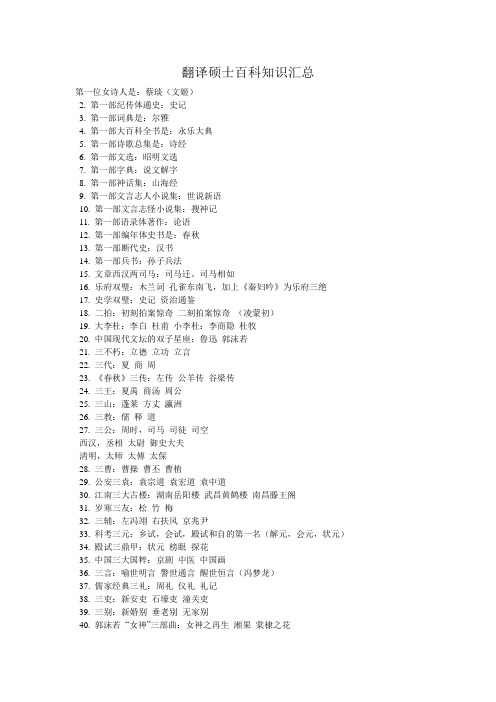
翻译硕士百科知识汇总第一位女诗人是:蔡琰(文姬)2. 第一部纪传体通史:史记3. 第一部词典是:尔雅4. 第一部大百科全书是:永乐大典5. 第一部诗歌总集是:诗经6. 第一部文选:昭明文选7. 第一部字典:说文解字8. 第一部神话集:山海经9. 第一部文言志人小说集:世说新语10. 第一部文言志怪小说集:搜神记11. 第一部语录体著作:论语12. 第一部编年体史书是:春秋13. 第一部断代史:汉书14. 第一部兵书:孙子兵法15. 文章西汉两司马:司马迁。
司马相如16. 乐府双璧:木兰词孔雀东南飞,加上《秦妇吟》为乐府三绝17. 史学双璧:史记资治通鉴18. 二拍:初刻拍案惊奇二刻拍案惊奇(凌蒙初)19. 大李杜:李白杜甫小李杜:李商隐杜牧20. 中国现代文坛的双子星座:鲁迅郭沫若21. 三不朽:立德立功立言22. 三代:夏商周23. 《春秋》三传:左传公羊传谷梁传24. 三王:夏禹商汤周公25. 三山:蓬莱方丈瀛洲26. 三教:儒释道27. 三公:周时,司马司徒司空西汉,丞相太尉御史大夫清明,太师太傅太保28. 三曹:曹操曹丕曹植29. 公安三袁:袁宗道袁宏道袁中道30. 江南三大古楼:湖南岳阳楼武昌黄鹤楼南昌滕王阁31. 岁寒三友:松竹梅32. 三辅:左冯翊右扶风京兆尹33. 科考三元:乡试,会试,殿试和自的第一名(解元,会元,状元)34. 殿试三鼎甲:状元榜眼探花35. 中国三大国粹:京剧中医中国画36. 三言:喻世明言警世通言醒世恒言(冯梦龙)37. 儒家经典三礼:周礼仪礼礼记38. 三吏:新安吏石壕吏潼关吏39. 三别:新婚别垂老别无家别40. 郭沫若“女神”三部曲:女神之再生湘果棠棣之花41. 茅盾“蚀”三部曲:幻灭动摇追求农村三部曲:春蚕秋收残冬42. 巴金“爱情”三部曲:雾雨电“激流”三部曲:家春秋43. 第一部国别史:国语44. 第一部记录谋臣策士门客言行的专集:国策战国策45. 第一部专记个人言行的历史散文:晏子春秋46. 第一位伟大的爱国诗人:屈原47. 第一首长篇叙事诗:孔雀东南飞(357句,1785字)48. 第一部文学批评专著:《典论·论文》(曹丕)49. 第一位田园诗人:东晋,陶渊明50. 第一部文学理论和评论专著:南北朝梁人刘勰的《文心雕龙》51. 第一部诗歌理论和评论专著:南北朝梁人钟嵘的《诗品》52. 第一部科普作品,以笔记体写成的综合性学术著作:北宋的沈括的《梦溪笔谈》53. 第一部日记体游记:明代的徐宏祖的《徐霞客游记》54. 第一位女词人,亦称“一代词宗”:李清照1. 我国第一部长篇讽刺小说:儒林外史2. 我国第一部介绍进化论的译作:严复译的赫胥黎的《天演论》,他是一个由不懂外,却成了翻译家的人。
Android百科名片
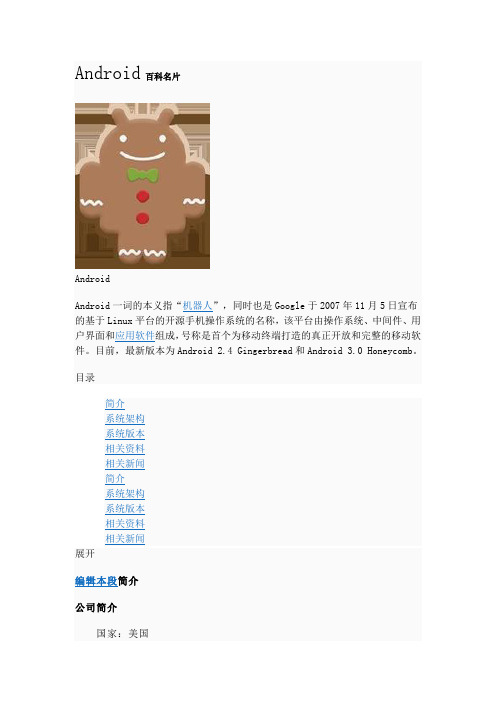
Android百科名片AndroidAndroid一词的本义指“机器人”,同时也是Google于2007年11月5日宣布的基于Linux平台的开源手机操作系统的名称,该平台由操作系统、中间件、用户界面和应用软件组成,号称是首个为移动终端打造的真正开放和完整的移动软件。
目前,最新版本为Android 2.4 Gingerbread和Android 3.0 Honeycomb。
目录编辑本段业务:手机软件,操作系统成立于:2003年创办人:Andy Rubin,Andy McFadden、Richard Miner Chris White 系统简介Android中文名:安卓(非官方)安致(官方)注:Google2005年8月17日收购美国Android公司得到手机巨头摩托罗拉的支持,摩托罗拉2010年放弃其他的操作系统(包括自家的Linux和UIQ)只支持Android。
Android的特色业务是手机软件,之后Google在其基础上发展了Android业务。
在Android发展的过程中,摩托罗拉付出的是核心代码,Google付出的是公关和品牌效应,当然还有它的google app,但是Google掌握了Android Market以及通过android google apps获得的大量用户。
Android一词最早出现于法国作家利尔亚当在1886年发表的科幻小说《未来夏娃》中。
他将外表像人的机器起名为Android。
Android是基于Linux开放性内核的操作系统,是Google公司在2007年11月5日公布的手机操作系统。
早期由原名为"Android"的公司开发,谷歌在2005年收购"Android.Inc"后,继续对Android系统开发运营,它采用了软件堆层(software stack,又名软件叠层)的架构,主要分为三部分。
底层Linux内核只提供基本功能,其他的应用软件则由各公司自行开发,部分程序以Java编写。
百科名片(流行)
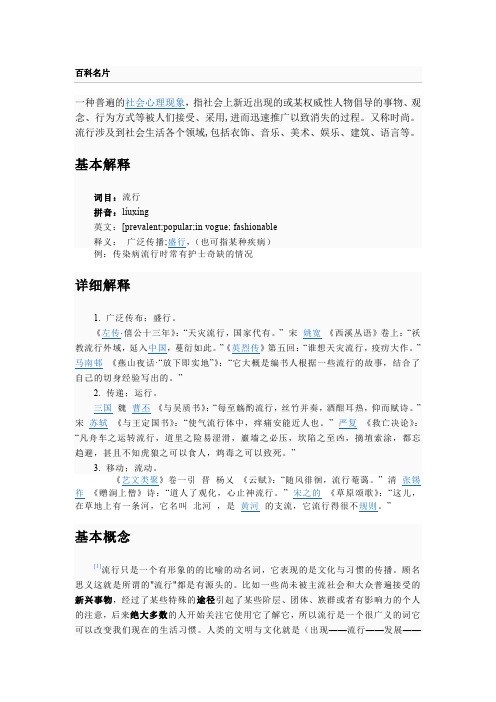
一种普遍的社会心理现象,指社会上新近出现的或某权威性人物倡导的事物、观念、行为方式等被人们接受、采用,进而迅速推广以致消失的过程。
又称时尚。
流行涉及到社会生活各个领域,包括衣饰、音乐、美术、娱乐、建筑、语言等。
基本解释词目:流行拼音:líuxíng英文:[prevalent;popular;in vogue; fashionable释义:广泛传播;盛行,(也可指某种疾病)例:传染病流行时常有护士奇缺的情况《艺文类聚》卷一引晋杨乂《云赋》:“随风徘徊,流行菴蔼。
” 清张锡祚《赠涧上僧》诗:“道人了观化,心止神流行。
” 宋之的《草原颂歌》:“这儿,在草地上有一条河,它名叫北河,是黄河的支流,它流行得很不规则。
”基本概念[1]流行只是一个有形象的的比喻的动名词,它表现的是文化与习惯的传播。
顾名思义这就是所谓的"流行"都是有源头的。
比如一些尚未被主流社会和大众普遍接受的新兴事物,经过了某些特殊的途径引起了某些阶层、团体、族群或者有影响力的个人的注意,后来绝大多数的人开始关注它使用它了解它,所以流行是一个很广义的词它可以改变我们现在的生活习惯。
人类的文明与文化就是(出现——流行——发展——普及)的过程。
从中我们可以看的这个世界有两种人:一种是带动和改变流行的人;二在后面永远吃灰的。
现在的多数所谓追逐流行的人,认为流行是时装、时髦、消费文化、休闲文化、奢侈文化、物质文化、流行生活方式、流行品味、都市文化、次文化、大众文化以及群众文化等概念所组成的一个内容丰富、成分复杂的总概念。
这个总概念所表示的是按一定节奏、以一定周期,在一定地区或全球范围内,在不同层次、阶层和阶级的人口中广泛传播起来的文化.特征衣饰、音乐、美术、娱乐、建筑、语言等都具有连续变化的可能性。
早在19世纪末期,法国社会学家G.塔尔德在《模仿的定律》一书中,美国社会学家T.B.凡勃伦在《有闲阶级论》一书中,都对流行现象做过研究。
- 1、下载文档前请自行甄别文档内容的完整性,平台不提供额外的编辑、内容补充、找答案等附加服务。
- 2、"仅部分预览"的文档,不可在线预览部分如存在完整性等问题,可反馈申请退款(可完整预览的文档不适用该条件!)。
- 3、如文档侵犯您的权益,请联系客服反馈,我们会尽快为您处理(人工客服工作时间:9:00-18:30)。
电子书百度百科名片目前国内学术界以及社会各界初步认定为:"电子书代表人们所阅读的数字化出版物,从而区别于以纸张为载体的传统出版物,电子书是利用计算机技术将一定的文字、图片、声音、影像等信息,通过数码方式记录在以光、电、磁为介质的设备中,借助于特定的设备来读取、复制、传输。
"它由三要素构成:(1)E-book的内容,它主要是以特殊的格式制作而成,可在有线或无线网络上传播的图书,一般由专门的网站组织而成。
(2)电子书的阅读器,它包括桌面上的个人计算机,个人手持数字设备(PDA),专门的电子设备,如"翰林电子书"。
(3)电子书的阅读软件,如ADOBE公司的AcrobatReader,Glassbook公司的Glassbook,微软的MicrosoftReader,超星公司的S SReader等。
可以看出,无论是电子书的内容、阅读设备,还是电子书的阅读软件,甚至是网络出版都被冠以电子书的头衔。
电子书的主要格式有PDF、EXE、CHM、UMD、PDG、JAR、PDB、TXT、BRM等等,目前很多流行移动设备都是支持其阅读格式的。
手机终端常见的电子书格式为UMD、JAR、TXT这三种。
电子书是一种便携式的手持电子设备,专为阅读图书设计,它有大屏幕的液晶显示器,内置上网芯片,可以从互联网上方便的购买及下载数字化的图书,并且有大容量的内存可以储存大量数字信息,一次可以储存大约30本传统图书的信息,特别设计的液晶显示技术可以让人舒适的长时间阅读图书。
电子书便携、容易使用、大容量的特点非常适合现代生活,数字版权贸易和互联网技术的发展,使电子书的用户可以以更低的价钱方便的购买到更多的图书,为电子书的流行奠定了基础。
电子书是否真的将带来网络时代的新的阅读方式,它是否真的能取代传统的阅读方式么?现在国内的PDA产品丰富,按功能大致分为三种:一是以学习为主,有各种英汉互译、字典等,如好易通、快易通等;二是以商务游戏为主,有记事本、万年历、汇率、股市行情、收发邮件、游戏等功能,如商务通、经理人、名人等;三是掌上电脑,可无线上网,WINDONS CE的操作系统。
目前的PDA产品有写已经加上了阅读电子书的功能,虽然还不完善,毕竟EBOOK正处在初期,很多都在观望,等待时机,整装待发。
国外EBOOK有SOFTBOOK、ROCKET BOOK、MICROSOFT READER等,国内目前还没有完整的EBOOK产品推出,它到底能否发展起来,是否会被PDA所兼容,能否发展以阅读为主功能的EBOOK。
微软全新推出一款POCKET PC,很COOL哦!有兴趣的话可以到微软的网站上DOWN他的推广片头,欣赏一下。
[编辑本段]电子书-含义来源电子书一般有2种含义,一指e-book,一指专门阅读电子书的掌上阅读器。
电子书的主要格式有PDF、EXE、CHM、UMD、PDG、JAR、PDB、TXT、BRM等等,目前很多流行移动设备都具有电子书功能。
电子书是支持其阅读格式的手机终端,常见的电子书格式为UMD、JAR、TXT这三种。
电子书是一种便携式的手持电子设备,专为阅读图书设计,它有大屏幕的液晶显示器,内置上网芯片,可以从互联网上方便的购买及下载数字化的图书,并且有大容量的内存可以储存大量数字信息,一次可以储存大约30本传统图书的信息,特别设计的液晶显示技术可以让人舒适的长时间阅读图书。
电子书便携、容易使用、大容量的特点非常适合现代生活,数字版权贸易和互联网技术的发展,使电子书的用户可以以更低的价钱方便的购买到更多的图书,为电子书的流行奠定了基础。
电子书是否真的将带来网络时代的新的阅读方式,它是否真的能取代传统的阅读方式么?现在国内的PDA产品丰富,按功能大致分为三种:一是以学习为主,有各种英汉互译、字典等,如好易通、快易通等;二是以商务游戏为主,有记事本、万年历、汇率、股市行情、收发邮件、游戏等功能,如商务通、经理人、名人等;三是掌上电脑,可无线上网,WINDONSCE的操作系统…目前的PDA产品有些已经加上了阅读电子书的功能,虽然还不完善,毕竟EBOOK正处在初期,很多都在观望,等待时机,整装待发。
国外EBOOK有SOFTBOOK、ROCKETBOOK、MICROSOFTREADER等,国内目前还没有完整的EBOOK产品推出,它到底能否发展起来,是否会被PDA所兼容,能否发展以阅读为主功能的EBOOK。
目前国内的Ebook主要有Foxit Eslick Book以及汉王的电子书。
[编辑本段]e-book电子书又称e-book,是将书的内容制作成电子版后,以传统纸制书籍1/3至1/2的价格在网上出售。
购买者用信用卡或电子货币付款后,即可下载使用专用浏览器在计算机上离线阅读。
电子图书不同于现在网上的免费线上阅读,它是与纸制版同步推出的最新书籍,所以阅读它要支付一定的费用;与光盘图书不同,e-book是基于因特网购买。
电子书的功能:可以订阅众多电子期刊、书和文档,从网上自动下载所订阅的最新新闻和期刊,显示整页文本和图形,并通过搜索、注释和超链接等增强阅读体验,采用翻页系统,类似于纸制书的翻页,可随时把网上电子图书下载到电子阅读器上,也可以自己购买的书和文档储存到电子阅读器上。
电子书是传统的印刷书籍的电子版本,它可以使用个人计算机或用电子书阅读器进行阅读。
它流行的原因就是因为电子书允许进行类似纸张书本的操作--读者可以在某页做书签,记笔记,对某一段进行反选,并且保存所选的文章。
另外,电子书阅读器还包括内置字典,可变字体和样式。
电子书的主要格式有PDF EXE CHM UMD PDG JAR PDB TXT等等目前很多流行移动设备都是支持其阅读格式的。
目前网上提供较多的是PDF格式的书籍下载,如目前就提供这类电子书下载。
现在手机电子书逐渐流行起来,大多附带阅读器的手机都支持TXT格式电子书的阅读,部分不附带阅读器的手机如诺基亚5300,也可以通过安装特定软件如"MOTO TXT"来支持电子书的阅读。
而大部分TXT格式电子书的下载都是以论坛的形式出现的,如猛将论坛)就是其中资源比较齐全,下载比较方便的一个社区[编辑本段]文件格式面对众多的电子书内容提供厂商和阅读设备,我们有必要了解一些常用电子书文件格式的知识。
PC上常用的电子书格式1.TXT文件格式这是目前比较流行也是被许多人青睐的一种电子读物文件格式,这种格式的制作工具也是最多的。
它最大的特点就是阅读方便,制作简单,制作出来的电子读物相当精美,这种格式电子书中内嵌了阅读软件,所以无需安装专门的阅读器就可以阅读,对运行环境并无很高的要求。
TXT格式的电子书在2004年以前主要应用于文本型的图书阅读,但是这种电子图书也有一些不足之处,如多数相关制作软件制作出来的TXT文件都不支持Flash和Java及常见的音频视频文件,需要IE浏览器支持等。
但是2004年以后,电子杂志和数字报纸开始流行,无一例外地都采用了EXE这种格式,并支持FLASH、多媒体甚至脚本语言,展现的内容更加丰富,制作相当精美,成为目前最流行的电子杂志的格式。
目前,方正阿帕比的飞阅、XPLUS、ZCOM等厂商提供的数字报、刊、书都采用了这种格式。
阅读软件:内嵌阅读器,无需额外阅读软件。
2.PDF文件格式(PDF(Portable Document Format)文件格式是Adobe公司开发的电子文件格式。
这种文件格式与操作系统平台无关,也就是说,PDF文件不管是在Windows,Unix还是在苹果公司的Mac OS操作系统中都是通用的。
这一特点使它成为在Internet上进行电子文档发行和数字化信息传播的理想文档格式。
越来越多的电子图书、产品说明、公司文告、网络资料、电子邮件开始使用PDF格式文件。
PDF格式文件目前已成为数字化信息事实上的一个工业标准。
Adobe公司设计PDF文件格式的目的是为了支持跨平台上的,多媒体集成的信息出版和发布,尤其是提供对网络信息发布的支持。
为了达到此目的,PDF具有许多其他电子文档格式无法相比的优点。
PDF文件格式可以将文字、字型、格式、颜色及独立于设备和分辨率的图形图像等封装在一个文件中。
该格式文件还可以包含超文本链接、声音和动态影像等电子信息,支持特长文件,集成度和安全可靠性都较高。
PDF文件使用了工业标准的压缩算法,通常比PostScript文件小,易于传输与储存。
它还是页独立的,一个PDF文件包含一个或多个"页",可以单独处理各页,特别适合多处理器系统的工作。
此外,一个PDF文件还包含文件中所使用的PDF格式版本,以及文件中一些重要结构的定位信息。
正是由于PDF文件的种种优点,它逐渐成为出版业中的新宠。
对普通读者而言,用PDF制作的电子书具有纸版书的质感和阅读效果,可以"逼真地"展现原书的原貌,而显示大小可任意调节,给读者提供了个性化的阅读方式。
由于PDF文件可以不依赖操作系统的语言和字体及显示设备,阅读起来很方便。
这些优点使读者能很快适应电子阅读与网上阅读,无疑有利于计算机与网络在日常生活中的普及。
Adobe公司以PDF文件技术为核心,提供了一整套电子和网络出版解决方案,其中包括用于生成和阅读PDF文件的商业软件Acrobat和用于编辑制作PDF文件的Illustrator等。
Adobe还提供了用于阅读和打印亚洲文字,即中日韩文字所需的字型包。
阅读软件:Adobe Acrobat8.1、Adobe Reader8.1、或其它第三方阅读软件。
3.CEB文件格式()CEB即Chinese eBook,是完全高保真的中文电子书的格式。
由北京方正阿帕比技术有限公司开发的全新的电子图书阅读工具--方正Apabi Reader使用的格式.它能够保留原文件的字符、字体、版式和色彩的所有信息,包括图片、数字公式、化学公式、表格、棋牌以及乐谱等,同时,该格式对文字图象等进行很好的压缩,文件的数据量小。
CEB版式文件技术基于方正全球领先的印刷出版技术之上,在版式文件技术领域已处于国际一流。
从2000年推出以来,方正CEB版式文件技术已在电子书、电子公文领域得到广泛应用。
同时,方正CEB版式文件技术可以方便的应用到方正在传统印刷出版领域的产品中。
CEB的优势和技术先进性:在不同的软硬件环境下保持显示不发生变化,生成后不可修改;融合了当前主要字型表示技术:包括各种编码体系和各种字库技术,支持少数民族文(蒙文、维文、藏文、韩文等)的转换;自动下载补字,保证CEB文件不发生"开天窗"的情况;提供全面图形处理技术(包括各种线形的完整描述);提供全面的图像和颜色处理支持及压缩(如多种色彩空间、包括ICC在内的色彩还原、RLE,G3,G4,Wavelet等数据压缩);支持电子签名,数据加密等安全机制;转换方便,几乎所有格式都可以转换成CEB格式,包括XML、S2、PS、PDF、TIFF、DOC、WPS等;CEB文件占用空间小,在排版比较复杂情况下,只有原来DOC文件的十分之一;CEB与XML结合,支持版面自动生成,支持信息提取,使用灵活;可以在CEB上制作目录、链接跳转,增加声音、动画和视频。
